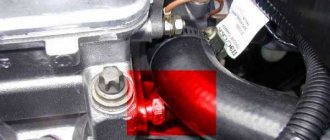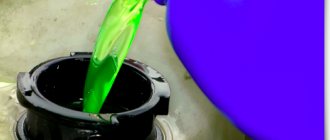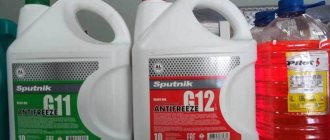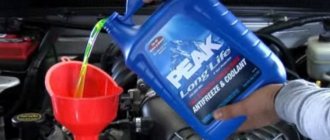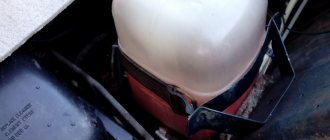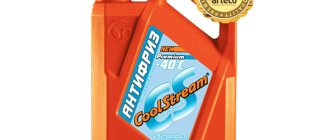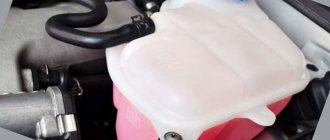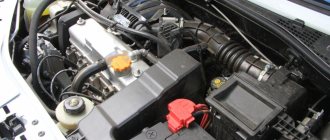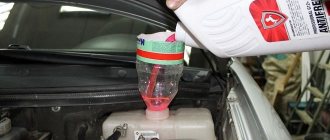02/04/2022 42 590 VAZ 2109
Author: Ivan Baranov
In this article we will look in detail at how to drain antifreeze on a VAZ 2109 and completely replace it. We’ll also look at how to fix a leak.
It is necessary to change antifreeze or antifreeze according to the manufacturer's instructions or if the vehicle is operated at low temperatures. Any brand of antifreeze has a certain operating temperature, when reduced, the process of its crystallization can begin. To carry out the work, we need a lift, overpass or inspection hole.
[Hide]
Replacement frequency
According to official regulations, the manufacturer provides for replacing the coolant in cars with carburetor or injection engines every 50,000–75,000 km. Such a long time interval is explained by the fact that it is at this interval of kilometers that the coolant begins to lose its properties. The use of used antifreeze is not permitted. Changing the coolant more often than once every 50,000 is unreasonable. km.
Signs of the need for urgent antifreeze replacement
The need to replace the coolant ahead of the official schedule may arise in several cases:
- If sediment has formed in the coolant. The presence of deposits in a substance indicates that it has begun to lose its properties. If sediment settles in a thick layer at the bottom of the expansion tank or in the pipes, it means that fluid cannot circulate effectively through connectors and channels. Refrigerant deposits are more noticeable at low air temperatures.
- Increasing the crystallization temperature of the coolant. To determine at what temperature a substance will begin to freeze, you need to check the density of the refrigerant. Diagnostics is carried out using a hydrometer. In the absence of a device, the increase in crystallization temperature can be determined visually. In such a refrigerant, yellow impurities appear. It will not be visible in the liquid itself, but can be clearly seen on the expansion tank cap in the space under the hood.
- Change in color of the refrigerant and formation of a brown tint. If the substance has acquired a browner color, this indicates the presence of corrosion deposits on the metal parts of the cooling system. Discoloration may be due to the fact that antifreeze has lost its functional properties.
- Drive unit overheating. If the problem is not related to mechanical defects in the car engine, you need to check the quality of the coolant.
Refueling procedure
After installing all the removed parts in place, you can begin the procedure for filling the cooling system. To properly fill antifreeze into a VAZ 2109, you will need almost 8 liters of liquid . First of all, old antifreeze is poured in. In this case, it is better to use gauze again. If the quality of the drained antifreeze does not inspire confidence, it is better to completely replace it with a new one.
Refueling occurs through the opening of the expansion tank, but all the liquid will not fit at once; you will have to warm up the engine so that it swallows the already filled volume and makes room for the remainder. It is important to remember that refueling is done to the minimum mark, because antifreeze expands when heated and can break through the pipes, tank or lid.
Level control and required volume
Before replacing the working fluid, the car owner must know the power of the cooling system of the “nine” and how much coolant it will use in order to purchase the required amount of fluid for the task at hand. When replacing, approximately 8.7 liters of antifreeze will fall into the plastic container under the lid. If you do not completely drain the working substance from the system, you will get about 7-7.5 liters. As for checking the level, it is carried out by marking the expansion tank in the engine compartment. Please note that when the car engine is warm, the volume of fluid may increase. Therefore, before checking, turn off the engine and let it cool.
Ideally, the refrigerant level should be between two marks - MIN and MAX.
For what reasons is coolant consumed?
There are several reasons why the volume of coolant in the cooling system decreases:
- Low sub-zero temperatures. In severe frost, the liquid decreases in volume. The reason for this cannot be called a leak, but car owners in winter often confuse this problem with a fluid leak. In the cold season, experts recommend adding coolant to the system.
- Formation of cracks and damage in the expansion tank or on its cover. As practice shows, if the defect on the tank is insignificant, it will not be easy to detect it visually. The crack may look like a scratch. Detailed diagnostics will be required. To determine the location of the leak, you will need a special dye added to the liquid.
- Insufficient tightness of linear connections or damage to pipe joints. This problem can be detected visually. The defects show wet traces of refrigerant. If the defect is minor, it is impossible to detect it using visual diagnostics. You will need to add dye to the refrigerant.
- The thermostat or gasket is damaged. If there is damage to the seal on the unit, fluid will leak out and the amount of fluid in the cooling system will decrease over time.
- Damage to the radiator device of the heating system. During operation, the cooler wears out. If the service life has already expired, the coolant may leak through cracks formed in it or the hose connected to it. It is not recommended to add fluid; the cooling radiator should be replaced.
- Presence of defects on the cylinder head gasket. If there is damage, there is a leak. As a result, the antifreeze will begin to mix with the engine oil, which will enter the coolant. The malfunction can be eliminated by replacing the cylinder head gasket.
Topping up
The refrigerant charging procedure is performed with a cold engine. To add antifreeze, open the hood of the car and unscrew the cap of the expansion tank. The required amount of liquid is poured into the container, then it is twisted and sealed.
If you do not know what fluid was used before, it is better to change it. Because mixing different types of refrigerants leads to a loss of properties of the substance.
What is better for VAZ 2109 antifreeze or antifreeze
Beginning car owners of the domestic automobile industry, learning the basics of car ownership, often ask various questions about servicing and repairing VAZs. One of the most frequently asked questions regarding the cooling system: which is better - Antifreeze or antifreeze for VAZ?
The question is quite interesting and is asked often, especially from owners who purchased a car, but were unable to get a clear answer from the former owner as to what was poured into the cooling system.
And before the winter period, when car preparation is required, this question comes up and makes you think. Let's try to figure it out.
Instructions for self-replacement
Below we will discuss how to change the coolant in a Nine.
What will be required for replacement?
If you are replacing the refrigerant yourself, do the following:
- key 8;
- 12 mm hex key;
- a cylinder or bucket into which you can fill the used refrigerant;
- If necessary, distilled water or a special solution for flushing the cooling system.
How to drain?
In order to completely drain the Antifreeze system on a VAZ 2109, you must perform the following steps:
- The car drives into a garage with a pit or onto an overpass. The surface on which the machine stands must be level. If it is not possible to provide such conditions, then the front of the car should be slightly higher. To do this, place the front wheels on a jack.
- Start the vehicle's powertrain and turn the heater control knob to the far right so that the heater blows out hot air.
- Stand under the car and remove the engine crankcase cover. To do this, unscrew the mounting screws.
- Stop the engine and loosen the negative battery terminal bolt. This is necessary to prevent short circuits during emptying.
- Remove the filler cap from the expansion tank. This will reduce the pressure when draining the exhaust gases.
- Place a container to collect “waste” under the drain plug on the cylinder block. After unscrewing the lid, the process of emptying the container of impurities will begin.
- After draining the water, replace the lid. Now you need to drain the working fluid from the radiator. To do this, unscrew the plastic cap on the radiator, after placing a container under it. Once the water has drained, screw the lid back on.
How to properly wash?
If the drained coolant is too dirty with traces of sediment, it is necessary to flush the cooling system. You can use distilled water or a special cleaner, which is sold at any car store.
The correct washing procedure is as follows:
- Distillate or rinse aid is poured into the VAZ 2109 power unit through the filler hole located on the tank under the hood. To do this, unscrew the cap and add enough fluid until the level is between the MIN and MAX marks on the tank.
- Start the car engine and let it idle for about ten minutes.
- Stop the engine and repeat the draining process.
- Assess the quality of the drained liquid. If it is too dirty and has traces of sediment, the washing procedure is repeated until the water becomes more or less clear.
Aveo Show user in his video showed the procedure for replacing antifreeze and cleaning the cooling system on a VAZ 2109.
How to fill?
Antifreeze must be filled as follows:
- Unscrew the reservoir cap in the engine compartment. For greater convenience, you can install a watering can in it.
- Make sure all plugs (drain plug and radiator cap) are securely tightened. Check the tightness of hoses and pipelines. Make sure the thermostat is in working order.
- Fill the expansion tank with fresh fluid. The coolant level should be between the MIN and MAX marks.
- Close the expansion tank cap and start the engine.
- Let the engine idle for approximately 10 minutes.
- Go under the vehicle's chassis and check for coolant leaks.
Photo gallery
Photos of replacing the refrigerant are shown below.
1. Open the hood and unscrew the reservoir cap
2. Move the heater control lever
3. Unscrew the plug on the radiator device
4. Fill the expansion tank with fresh refrigerant
What are the consequences of an untimely change?
If the replacement period is not met, the car owner will face the following problems:
- Antifreeze will not be able to perform the functions assigned to it. This will lead to the fact that at low temperatures the car's heating system will not work as efficiently. In some cases, the heater does not work at all.
- The circulation of the working fluid will be impaired due to deposits in the car radiator connections and the radiator assembly. This will lead to excessive heating of the drive. Prolonged use of the machine with an overheated engine can lead to machine failure.
So is it possible to mix?
Hypothetically, you CAN mix (but not everything and not always, let’s break it down into subgroups)! First, understand why you need this. I repeat once again, in any case, such a mixture can lead to improper functioning of the car’s cooling system. YOU NEED TO UNDERSTAND THIS! Well, now in more detail:
TOSOL and G11 - the same base, the same additives, you can mix without fear. Will work the same at any load and temperature
TOSOL sG12 – same base, different additives. Mixing is possible, but not advisable. The thing is that G12 works a little differently, it does not envelop the walls inside with a protective film, but fights the outbreaks (as I wrote above). As a result, in such a cocktail you get two types of additives, protective and anti-corrosion; how they will work together is not entirely clear. However, based on my experience, I can say that it is unlikely that sediment will form
TOSOL and G13 – mixing is not recommended at all. Firstly, G13 is a very expensive liquid (if you take the original one, say, produced by VOLKSWAGEN, it can cost up to 300 - 400 rubles a liter, and not that “badyaga”, which is produced I don’t understand where, and I don’t understand how, usually yellow) and pour in it TOSOL (or vice versa) is simply a crime, you are downgrading the class many times. Secondly, G13 uses propylene glycol instead of ethylene glycol (both are monohydric alcohols), but how they will interact with each other, and even at high temperatures, is UNCLEAR! Third, the additives here are different, G13 has a hybrid package of both anti-corrosion and protective additives, but antifreeze is only protective, in the end it’s also not clear what will happen. In such a mixture, there is a big possibility that sediment will form and the characteristics of this cocktail as a whole will drop (especially temperature), and this is bad - all the pipes and channels can become clogged, and boiling may already occur at temperatures less than 100 degrees, which is realistic is fraught with overheating.
Here is your answer, you can mix, BUT NOT EVERYTHING AND NOT ALWAYS!
